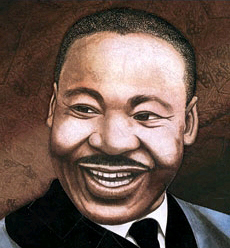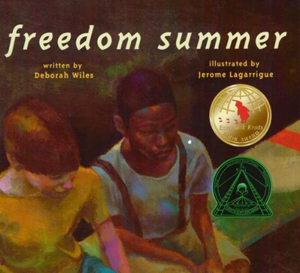
The Horn Book website has lots of material of interest to teachers. Here are some areas to explore. And follow us on Twitter: #lollysclass
|
Interviews with authors and illustrators Recommended books -- reviews and themed book lists |
School -- reading in school, author visits, and more Suggestion box: what else to you want to see in Lolly's Classroom? |
Applying Martin's big words
With the advent of the Common Core I have worked tirelessly this year to reboot my nonfiction units from something that was once a simple overview of headings, captions, and text features to an integrated understanding and application of nonfiction texts.
 With the advent of the Common Core I have worked tirelessly this year to reboot my nonfiction units from something that was once a simple overview of headings, captions, and text features to an integrated understanding and application of nonfiction texts. I feel often, however, that I have come up short, particularly in asking my students to compare texts. Yet this past week I think I may have reached the level of critical thinking among students that the Common Core calls for, thanks to authors Doreen Rappaport and Deborah Wiles.
With the advent of the Common Core I have worked tirelessly this year to reboot my nonfiction units from something that was once a simple overview of headings, captions, and text features to an integrated understanding and application of nonfiction texts. I feel often, however, that I have come up short, particularly in asking my students to compare texts. Yet this past week I think I may have reached the level of critical thinking among students that the Common Core calls for, thanks to authors Doreen Rappaport and Deborah Wiles.In honor of Martin Luther King, Jr. Day, my first grade class has been conducting a close reading of Rappaport’s Martin’s Big Words in conjunction with Wiles’s Freedom Summer.
My students had acquired a foundational knowledge of King via their “Social Justice” class; however, the illustrations and power of Rappaport’s work brought King’s famous speech to life. Rappaport’s text provides ample opportunities for students to dissect and truly analyze King’s dreams and thoughts.
 Martin’s Big Words, however, became overwhelmingly more concrete and powerful for students through a comparison with Wiles’s Freedom Summer. Focused on the friendship of young Joe and John Henry, this story is a subtle, yet powerful, look at race relations in American history. The young narrator’s point of view coupled with the text’s simple storyline makes this an easily accessible book for younger readers and lends itself to a class discussion on fairness, friendship, and Civil Rights.
Martin’s Big Words, however, became overwhelmingly more concrete and powerful for students through a comparison with Wiles’s Freedom Summer. Focused on the friendship of young Joe and John Henry, this story is a subtle, yet powerful, look at race relations in American history. The young narrator’s point of view coupled with the text’s simple storyline makes this an easily accessible book for younger readers and lends itself to a class discussion on fairness, friendship, and Civil Rights.In tracking the varying experience of Joe, a white boy, and John Henry, his black best friend, students were able to identify specific instances of racial injustice. Through this textual analysis, students seemed to truly experience what King was fighting for in his Big Words.
The combination of these texts and what students were able to notice was truly remarkable. I’d recommend this textual pairing to anyone in search of a thoughtful analysis of the 1960s.
Check out the Horn Book's list of 25 more recommended books for suitable for Black History Month -- and year 'round -- here.
RELATED
RECOMMENDED
ALREADY A SUBSCRIBER? LOG IN
We are currently offering this content for free. Sign up now to activate your personal profile, where you can save articles for future viewing.







Add Comment :-
Comment Policy:
Comment should not be empty !!!
Maureen Milton
When my 2nd & 3rd graders were studying dinosaurs and prehistory earlier this year, I read (over a few sessions) Kudlinski's "Boy Were We Wrong About the Dinosaurs!" along with excerpts from the charming and dated Burton's "Life Story" and the freshly minted Thimmesh's "Scaly, Spotted, Feathered, Frilled" and finally Kerley's "The Dinosaurs of Waterhouse Hawkins." They are naturally interested in thinking about science as an unfurling of evidence and a coalescing of theory. In addition, in January, when we return from break, I usually read to K-2s these 3 titles: Berger's "Germs Make Me Sick" (an unsuspected spellbinder), Shannon's "A Bad Case of Stripes" and, of course, Stead's "A Sick Day for Amos McGee."Posted : Feb 12, 2014 06:51
Elizabeth Vaccaro
I loved pairing My Ol' Man by Patricia Polocco with Rocks in His Head by Carol Otis Hurst. Both set in the depression and both had the passion for something being the key to a better life. Could be extended to nonfiction reading about hobbies.Posted : Feb 11, 2014 10:05
Lolly Robinson
I wish I could remember who it was who suggested pairing The Giving Tree by Shel Silverstein with Piggybook by Anthony Browne. Maybe KT Horning or Susan Bloom? Or Cathie Mercier in criticism? Reading The Giving Tree from a feminist perspective sure does change things!Posted : Feb 11, 2014 09:01
Teddy Kokoros
Interesting article. I like the idea of pairing the books to give context. I am curious as to how Whitney's classroom and others who have read Martin's Big Words have handled the part of the book when MLK is assassinated. When I did an internship 10 years ago in a Kindergarten I actually skipped over that part because I was worried children would not be able to handle it and regretted the choice after. Since I have become full time teacher I no longer gloss over his assassination and have found it sparks a lot of lively and thoughtful discussion among the Pre-K children about violence, guns, and death. I usually email the parents before hand to let them know we will discuss MLK including the fact he was assassinated before hand to see if they have any concerns or reservations about discussing those topics. There have rarely been cases when there were concerns we could not address with the parents but in a couple instances parents strongly did not want third children to lose their innocence by hearing the full story so we gave the children an alternative activity to do during that time.Posted : Feb 11, 2014 05:49
Sam Juliano
Wonderful work here for sure! This extraordinary picture book will remain relevant for many a generation, and it's one that has culled emotional responses from many youngsters wanting to learn about this great man. I remain convinced it's the most artistically exquisite of all the MLK books, though coming from Brian Collier, that's a given. In response to Lolly's query, and I am assuming you are asking us to leave the MLK box here, I have always found that theme related pairings work exceptionally well, in addition to some obvious groups like the Pinkney and Spier versions of NOAH'S ARK and the Zelinsky and Hyman renditions of RAPUNZEL to name just a few. THE MATCHBOX DIARY and the sublime PEPPE THE LAMPLIGHTER work quite well together, and for some wordless mayhem I have always paired Bang's THE GREY LADY AND THE STRAWBERRY SNATCHER with THE RED BOOK. Wonderful post.Posted : Feb 11, 2014 01:52